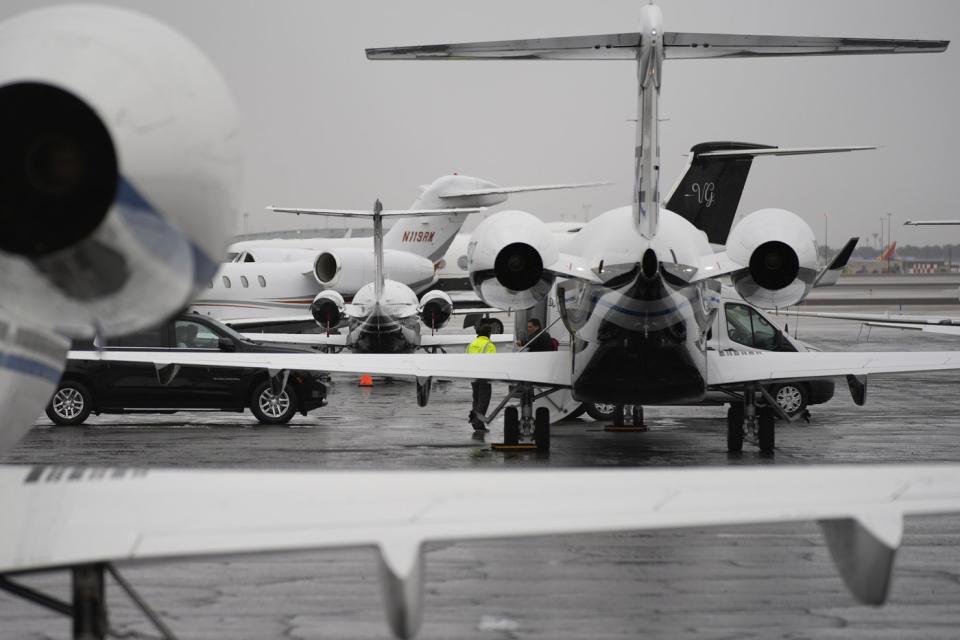Private jets descend on Montreal for F1 Grand Prix in emissions-heavy weekend

MONTREAL — Formula One does things big.
At the Canadian Grand Prix, its race cars top 300 kilometres per hour. The track in Montreal amounts to a 305-kilometre contest over 70 white-knuckle laps. Past attendees include Rihanna, Al Pacino, Penélope Cruz and Tom Brady. Last year, a record 345,000 fans packed into the Circuit Gilles Villeneuve.
But biggest — and priciest — of all may be the private jets carrying thrill-seeking visitors to the city this weekend for the event.
About 115 business jets will descend on the Montreal area Friday through Sunday, which amounts to a 50 per cent spike from the daily average over the preceding month, according to projections provided to The Canadian Press by analytics firm WingX.
Last year saw 139 business jet arrivals from the U.S., Canada and as far as Italy on the event weekend, up 43 per cent from 2019 and in line with rising demand for private air travel since the COVID-19 pandemic.
Emissions, too, are slated to rise, due to the race itself but especially the aircraft activity around it.
“The private jets obviously have an outsize impact, because a private jet is bringing so few people on it, so inefficiently,” said Thomas Green, a climate policy adviser at the David Suzuki Foundation.
“And it can be even worse if the private jet is travelling to the event with some people and then going back empty somewhere else to pick up another flight, if it’s chartered.”
Indeed, some 20 business jets made multiple landings in Montreal for last year’s Grand Prix weekend. After touching down, some likely took off without passengers in order to shuttle more back to the city over the next couple of days.
Pinning a precise number on the carbon dioxide emissions from a flock of private jets can be hard. But in general, the pricey planes are five to 14 times more polluting than commercial aircraft on a per-passenger basis, according to Brussels-based advocacy group Transport & Environment.
A private jet can emit two tonnes of carbon dioxide in a single hour, the organization states. Compare that with data from the Canada Energy Regulator, which says the average Quebec resident accounts for fewer than nine tonnes over an entire year.
“When we look at global aviation passenger emissions, just one per cent of people cause 50 per cent of the emissions,” Green said.
“That’s a lot of the super-rich and it’s a lot of the executive class taking a lot of business-class flights or, again, the private jets. And they’ve been increasing quite quickly.”
That class includes the champagne-soaked world of F1, where big-money sports melds with European aristocracy in a high-octane show of competition, glamour and ego.
Although seven-time champion Lewis Hamilton reportedly sold his cherry-red Challenger — made by Quebec’s Bombardier Inc. — for environmental reasons, current leader Max Verstappen wings around the globe on a private Dassault Falcon purchased from billionaire entrepreneur Richard Branson. Some teams, including Scuderia Ferrari, have partnered with firms such as VistaJet for private charter flights.
Barry Prentice, who heads the University of Manitoba's transport institute, says the role of private planes in fostering business relationships, economic activity and tourism should factor into equations of their overall impact.
“Time is money,” he said.
“You need to meet in person for negotiations, as well as personally going and having a look — how is the factory doing? You can’t do that by Zoom.”
Convenience and even wasted wages can also play a role in private jets’ appeal.
“We’ve all been slogging through airports and going through the dismal process of security checks,” Prentice said. “You’re paying people in the executive offices — there's a lot of wages that are lost while they're waiting.”
The jet set helps to rev up the tourism buzz that surrounds the Grand Prix.
Formula One marks the unofficial kickoff to Montreal's summer festival season, as pedestrians ogle high-priced cars and explore F1-themed booths on Crescent Street downtown ahead of the Maxim Grand Prix Party on Saturday night.
"It became the red carpet experience of Montreal," said Jean-Paul Mouradian, vice-president of Feldman Entertainment Quebec, which promotes the unofficial F1 event, held within the limestone walls of a former Canadian Pacific Railway station.
Tickets range from $260 to an eye-watering $20,000, with this year's guests including Quebec tennis pro Eugenie Bouchard, American social media sensation Sommer Ray and Moroccan-American rapper French Montana.
"We've heard from airports — from Saint Hubert, Montreal, Mirabel — that many private jets were landing," Mouradian said, referring to the three main airports that surround the city.
The crowds downtown have only increased since a docuseries cranked up F1's popularity starting in 2019.
"It's the 'Drive to Survive' from Netflix," he said. "It made it so frenzied."
The F1 teams, crews and other personnel alone — some of them in business jets — will number nearly 3,000 this weekend, according to the Canadian Grand Prix.
"The Netflix crew is actually quite small. It’s usually less than five people," said brand strategy head Sandrine Garneau.
Amid all the high-flown excitement around elite motorsport, Thomas Green argues that any approach to business jets needs to be grounded in sturdier regulation.
"It's great when someone shows leadership and changes their lifestyle to reduce emissions, but we can't count on that," said the environmental advocate, referring to Lewis's bizjet sale as well as pop superstar Taylor Swift's carbon credit purchases.
"We need policies that help bring down emissions across the economy," he said. "These small jets aren't paying proportionally and they're having outsize impacts on emissions."
This report by The Canadian Press was first published June 7, 2024.
Christopher Reynolds, The Canadian Press

 Yahoo Finance
Yahoo Finance 